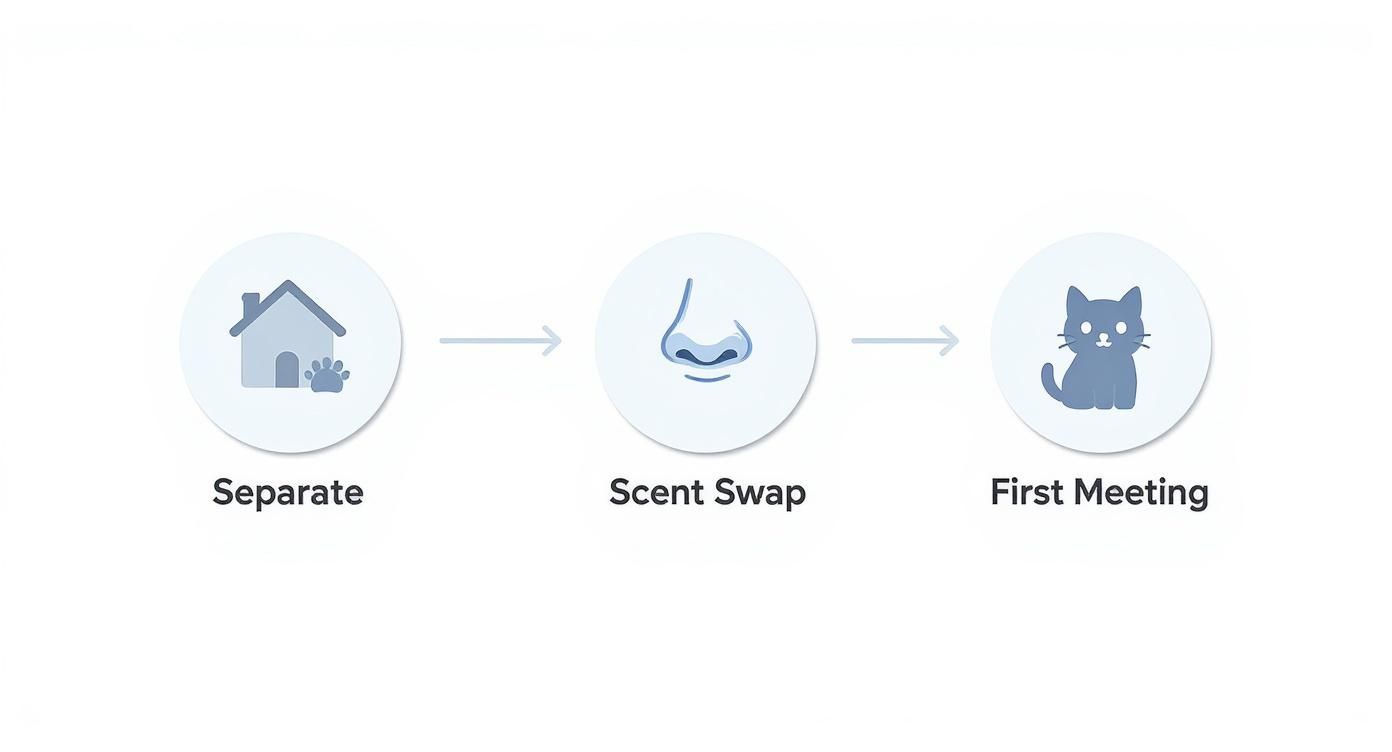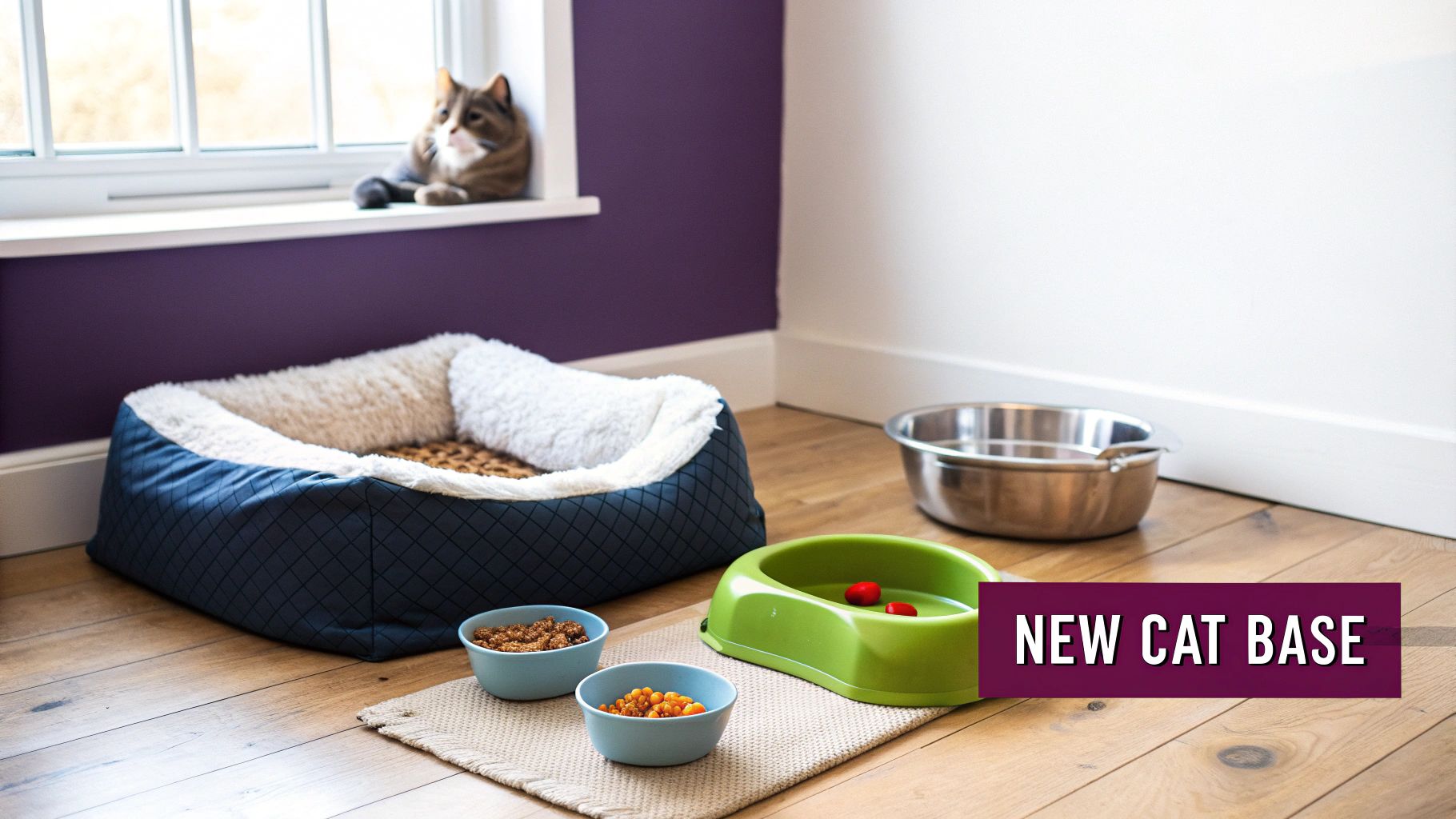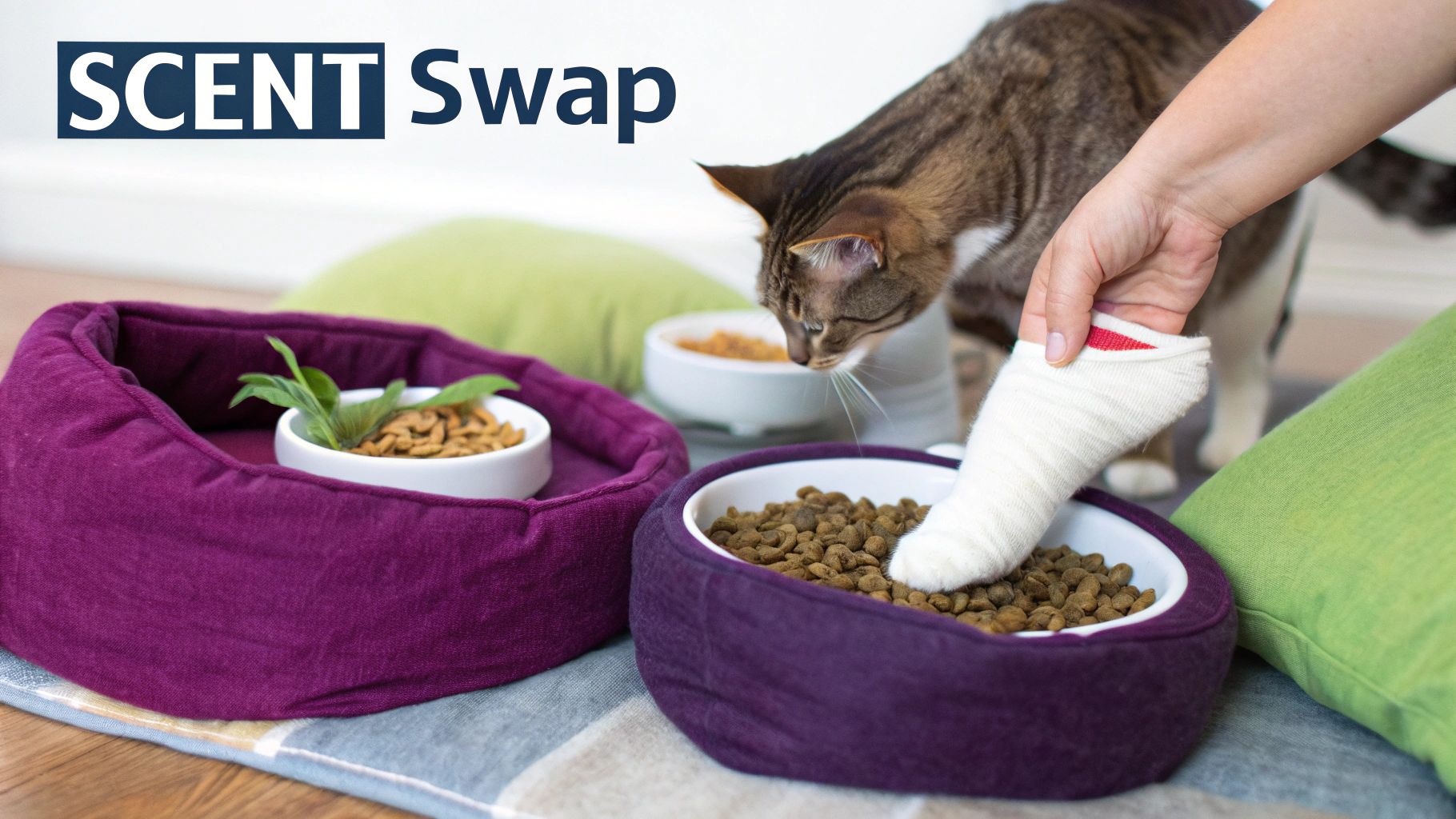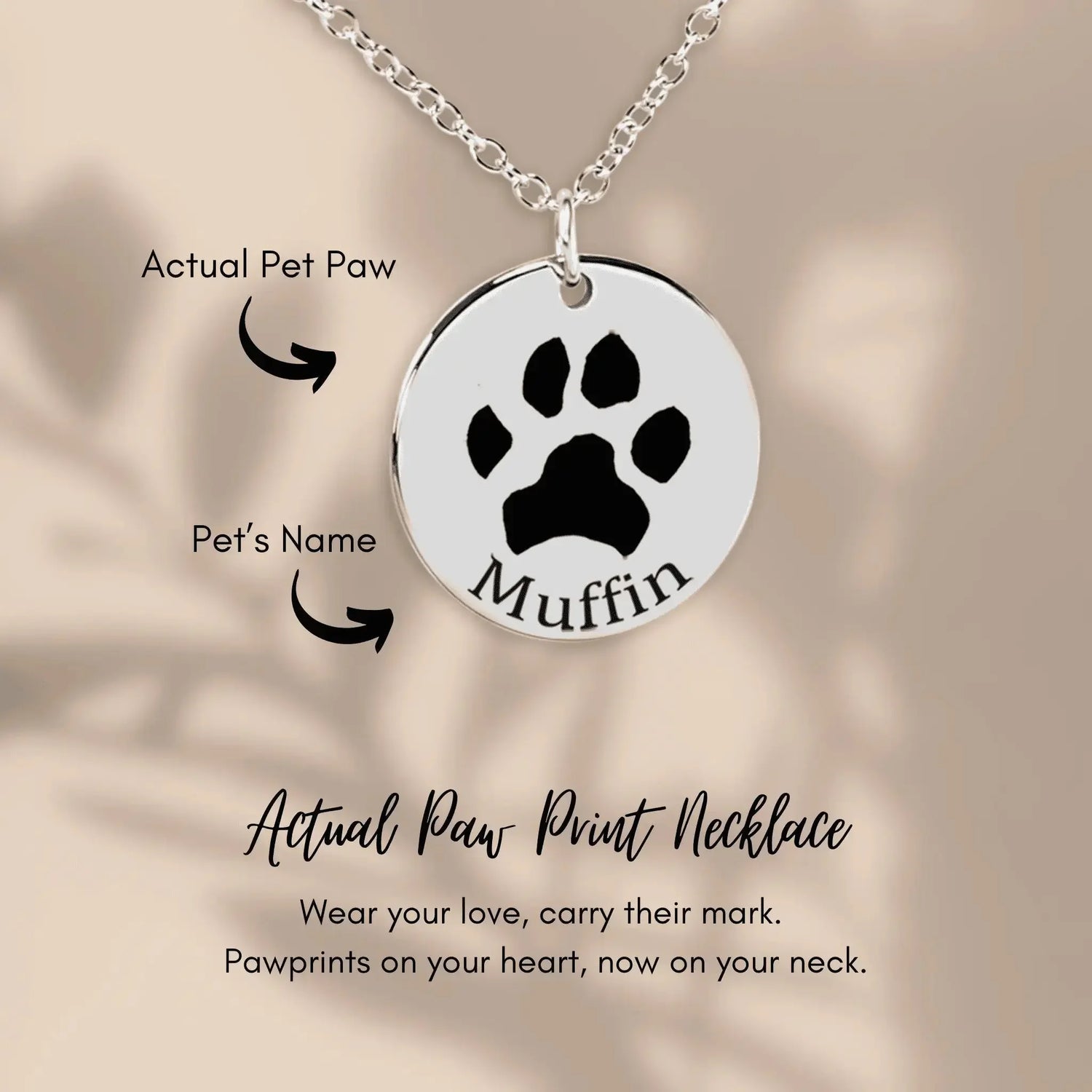How to Introduce Cats to Each Other: A Pawsitive Guide 💖

Ready to turn your home from a hissing battleground into a purr-fect paradise? Floofie, our mascot, says the secret to a successful cat introduction is going slow and letting them get used to each other's scent before they ever meet face-to-face. This gradual, patient process respects their territorial nature and sets the stage for a lasting friendship. Meowza!
Creating Harmony in Your Multi-Cat Home
Dreaming of your cats cuddling up together like our mascot Floofie and his pals? You're in the right place! 💖 Introducing a new cat can feel like a high-stakes mission, but I promise it's more about patience than panic.
This guide is your friendly playbook for a peaceful, scent-driven process that respects your cat's natural instincts. We'll walk you through everything from setting up separate safe zones to orchestrating that magical first meeting.
Think of yourself as a feline matchmaker. With these tips from Floofie, you're about to become the ultimate cupid. Let’s get your furry family started on the right paw! 🐾
The Floofie Philosophy: A Peek at the Process
Understanding the journey ahead can make it feel much less daunting. It's not about throwing them together and hoping for the best; it's a structured approach built on positive reinforcement.
This simple infographic breaks down our paw-some process for a smooth introduction.

As you can see, the method prioritizes separation and scent before any visual contact. That right there is the cornerstone of a successful feline friendship.
Here’s a quick peek at the key phases for a successful cat introduction, breaking down the goal and primary activity for each stage.
Cat Introduction At-a-Glance: The Floofie Method
| Phase | Main Goal | Key Action |
|---|---|---|
| 1: Total Separation | Create a sense of security and avoid initial conflict. 😼 | Keep cats in separate rooms with zero physical or visual contact. |
| 2: Scent Swapping | Familiarize each cat with the other’s scent in a non-threatening way. 👃 | Exchange bedding, toys, and rub cloths between their separate spaces. |
| 3: Brief Visuals | Allow cats to see each other from a safe distance. 👀 | Use a baby gate or cracked door for short, supervised visual meetings. |
| 4: Supervised Meets | Build positive associations during face-to-face interactions. 🥳 | Allow short, controlled meetings in a neutral space, using treats and toys. |
This table just scratches the surface, but it gives you a solid roadmap for what’s to come as you help your kitties get acquainted.
Why Slow and Steady Wins the Race
Cats are social, but their relationships are complicated. Their social circles often form around essential resources like food, water, and safe sleeping spots. Early life experiences, especially between 4 and 8 weeks old, play a huge role in shaping how they interact with other cats down the road.
By mimicking a natural, gradual meeting, you're speaking their language. This approach tackles the biggest sources of cat conflict head-on:
- Territorial Anxiety: Giving each cat their own secure space prevents them from feeling like an invader is taking over their turf.
- Fear of the Unknown: Scent swapping introduces the idea of the other cat in a safe, non-threatening way long before they ever lay eyes on each other.
- Negative Associations: By carefully managing every step, you ensure their initial interactions are positive and rewarding, not scary.
A calm environment is your best friend during this time. Beyond managing their interactions, keeping your home healthy means using products like pet-safe carpet cleaning solutions to keep their spaces fresh without harsh chemicals.
Floofie says: "Remember, the goal isn't to force an instant friendship. It's to build a foundation of tolerance and trust that can blossom into a beautiful bond over time. A little extra effort now prevents a whole lot of stress later." 🧘
If you notice your resident kitty seems extra on edge, it might be a good time to review our guide on how to reduce cat anxiety for some extra calming tips.
Setting Up Separate Sanctuaries
Before your new cat even sets a paw inside, a little prep work can make all the difference. Think of yourself as a feline diplomat, and your first mission is to create two separate, safe territories. This isn't about punishment; it's about giving both your resident cat and the newcomer the personal space they need to feel secure from the get-go. 👑

This initial separation is one of the most crucial steps. By preventing a stressful, immediate face-off, you're laying the groundwork for a future friendship instead of a furry feud. Let's get those purr-fect sanctuaries set up.
Crafting the New Cat's Base Camp
Your new arrival needs a dedicated "base camp" where they can decompress without feeling overwhelmed. This should be a room your current cat is absolutely not allowed to enter for now. A spare bedroom, home office, or even a large, quiet bathroom can work perfectly. The goal is to make this space feel like an all-inclusive resort of comfort.
Make sure this temporary home is fully stocked with everything they need to live their best life. This simple step prevents them from having to brave scary, unknown territory just to get the essentials.
Here’s a quick checklist for the ultimate welcome suite:
- A Private Litter Box: A clean, easy-to-access litter box is a must. This helps avoid any territorial stress around bathroom habits.
- Dedicated Food and Water Bowls: Keep their food and water separate and place them far away from the litter box.
- A Cozy Bed: A soft, secure spot to nap is essential. A plush hideaway like our super-soft Floofie Calming Bed is perfect for helping a new cat feel safe and tucked away.
- Engaging Toys: A few different toys will keep them busy and mentally stimulated, which is a great way to bust stress.
- A Scratching Post: Giving them an appropriate place to scratch lets them mark their new, small territory and burn off some nervous energy.
This room will become their safe haven—a space that smells only like them. It's their anchor in a big, new world. Before bringing them home, take a final look from a cat's perspective. For more tips on getting their space ready, check out our complete guide on how to cat-proof your home.
Maintaining Zen for Your Resident Cat
While the newcomer gets settled, it’s just as important to keep your resident cat's world as stable and predictable as possible. Cats are creatures of habit, and even small changes—like a suddenly closed door or strange smells—can be enough to cause anxiety. Your original kitty is still the ruler of the household, so make sure they feel that way!
Floofie reminds you: The key is to minimize disruption for your current cat. Sticking to their regular feeding times, play sessions, and cuddle routines reinforces that their status and resources are not under threat. They need to know they are still your #1.
To create an even more tranquil vibe for both cats, consider plugging in a calming pheromone diffuser, like Feliway. These release a synthetic version of the feline facial pheromone, sending signals of safety and well-being. Placing one near the new cat's room and another in your resident cat's favorite hangout spot can really lower the stress levels for everyone involved. Think of it as creating a zen spa atmosphere before they even officially meet. 😉
Mastering the Art of Scent Swapping
Alright, let's talk about a cat’s favorite social media platform: scent! 👃 For our feline friends, smell is everything. It’s how they identify friends, mark their turf, and get all the hot gossip.
So, before your kitties ever lock eyes, we’re going to get them acquainted through their noses first. Our mascot Floofie calls this the “Scent Sniffari,” and it’s the most important game you’ll ever play.

This whole phase is about building positive associations with each other's smell without the stress of a face-to-face meeting. You’re essentially creating a positive profile for the new cat in your resident cat’s mind, and vice versa. By controlling the narrative, you can make sure their first impression is a five-star review.
The Great Scent Exchange
The simplest way to start is by swapping items that carry their unique scent signatures. Think of it as exchanging business cards. This builds familiarity in a super low-pressure way, letting them investigate the newcomer on their own terms.
Here’s how to kick off the exchange:
- Bedding Swap: Take a blanket or bed from each cat’s safe space and place it in the other’s room. Don’t force them to interact with it; just leave it there for them to discover.
- Toy Trade: Grab a favorite toy from each cat and swap them. This links the new scent with something fun and positive like playtime.
- Sock Method: This one is Floofie’s favorite! Gently rub each cat with a separate, clean sock or cloth, focusing on their cheeks and the base of their tail where their scent glands are strongest. Then, place the scented sock in the other cat's territory.
The goal is for them to encounter the new scent passively. A calm, curious sniff is a huge win! If you get a hiss or they avoid the item, it just means they need more time. No biggie!
Floofie's Pro Tip: Place the scented item near their food bowl. This creates a powerful connection: "This new smell appears when delicious food arrives... maybe this new creature isn't so bad after all!" 😋
Reading Their Scent Signals
Your cats' reactions to the scented items are your progress reports. Paying close attention to their body language will tell you exactly when you’re ready to move on.
What you're looking for is a shift from negative or fearful reactions to neutral or even positive ones. Initially, you might see some hissing or swatting at the scented blanket. That’s totally normal! It’s just their way of saying, “Whoa, who is THIS?!”
Over a few days of consistent swapping, you should notice a change.
- Green Light Behaviors ✅: Ignoring the item, giving it a casual sniff and walking away, rubbing their own face on it (this is jackpot behavior!), or even sleeping on the swapped bedding.
- Red Light Behaviors 🛑: Hissing, growling, puffing up, actively avoiding the part of the room with the item, or worse, urinating on it.
If you’re seeing red lights, don’t panic. It just means you need to take the scent swapping slower. Keep at it daily until the reaction becomes neutral. Patience is your superpower here.
Scent and Socialization
This gentle introduction process is especially critical because of how cats learn to socialize. Research shows that the primary socialization period for kittens is between 2 and 9 weeks of age. During this brief window, positive exposure to new things—like other cats, people, and household noises—is essential for developing good long-term social skills. Cats socialized properly during this time tend to be less fearful as adults. You can explore more about these crucial developmental stages in this detailed study on kitten socialization.
Even if you’re introducing adult cats well past this age, applying the same principles of slow, positive exposure through scent swapping taps into their innate learning process. It honors their need for security while gently expanding their social world. By mastering this step, you’re not just introducing cats; you’re setting the foundation for a lifetime of friendship. 💖
Managing the First Visual Meetings
After a successful "Scent Sniffari," the energy in your home has probably shifted. Both cats are likely calm and curious about each other’s smells, which is a fantastic sign. It's time for the big reveal! 🤩
But hold on—we're not just flinging the door open and hoping for the best. The first few times your cats see each other are critical, and we need to manage it carefully. Floofie calls this the most delicate part of the whole introduction process.
The goal here is simple: make seeing the other cat the absolute best part of their day. We're aiming for short, sweet, overwhelmingly positive peeks that leave them feeling good, not threatened. This is where patience and some seriously tasty rewards come in to turn a potentially tense stare-down into a peaceful first encounter.

Creating a Safe Viewing Barrier
First things first, you need a see-through barrier. This is non-negotiable. It allows the cats to see each other without any risk of a physical fight, which could set your progress back weeks. They need to feel completely secure, knowing they can observe the newcomer without being pounced on.
Here are a few solid options:
- A Sturdy Baby Gate: This is the classic choice for a reason! A pet-specific gate that’s tall enough to prevent jumping is perfect. If you have a feline acrobat, you might need to stack two gates to be safe.
- A Screen Door: If you happen to have a spare screen door you can install in the doorway, it works wonderfully.
- A Cracked Door: You can also prop the door to the safe room open just a tiny crack, held securely with a heavy doorstop. This is a great starting point if a full view feels like too much, too soon.
Whatever you do, never use a cat carrier as a barrier. Forcing one cat into a carrier and then exposing them to a potential threat is a recipe for disaster. It creates a powerful negative association with both the other cat and the carrier itself. A trapped, scared cat is not in the right mindset to learn.
The Power of Positive Association
Now for the fun part: treats! The secret ingredient to this entire process is positive reinforcement. You want to rewire their brains to think, "When I see that other cat, amazing things happen to me!"
This is where you break out the good stuff—the high-value treats they absolutely go nuts for. Think freeze-dried chicken, tuna flakes, or those irresistible lickable treats. Their everyday kibble just won't cut it for this task.
A great way to start is by scheduling their main meals on opposite sides of the barrier.
- Place their food bowls far enough from the gate that they can eat comfortably without feeling pressured. They should be able to see each other, but not feel threatened.
- If they eat calmly, that's a huge win! 🎉 The next day, you can try moving the bowls just a few inches closer.
- Continue this process over several days or even weeks, slowly closing the distance until they can eat peacefully right next to the gate.
This "eat-and-greet" method is incredibly effective. It teaches them that the other cat's presence actually predicts something wonderful (a delicious meal), which helps override their instinct to be defensive.
Floofie says to keep these initial visual sessions very short—just a few minutes at a time. Always end on a positive note, before anyone gets overwhelmed or starts staring. It's much better to leave them wanting more than to push them too far.
Decoding Their Body Language
Your cats will tell you exactly how they're feeling, so it's your job to become fluent in feline body language. Knowing when to push forward and when to take a step back is what will make this introduction a success.
Keep a close eye out for these signals during your visual meetings.
Green Lights (Proceed with Caution) ✅
- A relaxed, loose body posture.
- Curious sniffing in the direction of the other cat.
- The "slow blink," which is a major sign of trust and comfort.
- Ignoring the other cat to eat or groom themselves.
- Tail held in a neutral or high, happy position (maybe with a little question-mark curve at the tip).
Yellow Lights (Slow Down) 🟡
- Intense, unblinking staring.
- A low, quiet growl or a soft hiss.
- Ears turned slightly back or flattened against their head.
- A tail that is twitching nervously or thumping on the floor.
Red Lights (Stop Immediately) 🛑
- Loud, sustained hissing, spitting, or growling.
- A puffed-up "bottle brush" tail and fur standing on end.
- Crouching low to the ground in a defensive or pre-pounce stance.
- Swatting at the barrier.
If you see yellow or red light behaviors, calmly and quietly end the session by closing the door. Don't scold them! This behavior is just information. It's telling you that you moved a bit too fast. Next time, simply increase the distance between them or make the session even shorter.
For a deeper dive into these signals, you can learn more about what cat tail positions mean in our detailed guide. Mastering this will make you a true cat whisperer.
Supervising Playtime and Building Friendship
This is it—the big moment you've been working toward! After all the scent swapping and peaceful gate greetings, your cats are finally ready for some supervised face-to-face time. Your job now shifts from careful diplomat to fun-loving party host. 🎉
The goal here is simple: make every interaction a positive one. We’re moving beyond just eating near each other and into the world of shared activities. This is how you build a real friendship—or at least a peaceful truce—on a foundation of good vibes.
Kicking Off with Shared Play
The best way to start is in a neutral space, like the living room, where neither cat feels like they're defending their turf. And the absolute best icebreaker? A shared play session. Getting both cats focused on a single toy is a brilliant way to redirect their attention from each other to a mutual, exciting goal.
A long wand toy is your greatest ally here. Something like our Floofie Feather Teaser is perfect because you can keep a safe distance between the cats while they both chase the "prey." You can flick it back and forth, letting each kitty have a turn to pounce without getting all up in the other's personal space. This teaches them that being together means fun things happen!
Keep these first sessions short and sweet—just 5 to 10 minutes is plenty. You always want to end things on a high note, long before anyone gets tired, cranky, or overstimulated. When playtime's over, give them both a tasty treat and calmly pop the new cat back in their safe room.
Floofie’s Pro Tip: Always end the interaction before your cats do. If you wait until you see a hiss or one cat walks away, you've already pushed it too far. A successful session is one that ends with both cats still happy and engaged.
Troubleshooting Common Behaviors
Even with perfect prep, you might hit a few bumps. Don’t worry, our mascot Floofie has seen it all! Knowing how to calmly handle these moments is key.
- The Staring Contest: Intense, unblinking staring is pure tension. If you see this, don’t shout or make a sudden move. Just redirect their focus by tossing a soft toy away from them or bringing out the wand toy to get them moving again. The idea is to simply break their focus on each other.
- Minor Swatting or Hissing: A quick, claws-in swat or a single hiss isn't the end of the world; it’s just communication. It's your cat's way of saying, "Hey, you're a little too close." If this happens, calmly create more space between them and try to re-engage them in play. If the tension doesn't fade, it's time to end the session for the day.
As they get more comfortable, you can gradually increase the length of their time together. Patience and consistency are everything when you're building trust between them.
The Impact of Environment and Health
As you work on building this new feline friendship, remember that a cat's background and current living situation play a massive role in their confidence. Things like their socialization history and whether they're spayed or neutered can significantly influence how they interact. For instance, research from Italy found that neutered cats, both male and female, show far less aggression—like biting and chasing—than intact cats.
The study also showed that cats in homes with plenty of toys and stimulation had lower stress scores. This just confirms what we already know: a fun, resource-rich home makes for happier, more social cats. You can read more about how environment impacts feline social behavior in the study.
This is why having plenty of resources scattered around your home is so critical. To keep territorial spats from flaring up, make sure you have:
- Multiple Litter Boxes: The golden rule is one per cat, plus one extra. Place them in different locations.
- Separate Food and Water Stations: No one should ever feel like they have to compete for a meal.
- Plenty of Vertical Space: Cat trees and shelves give them an easy escape route and a safe place to observe from a distance.
- Multiple Scratching Posts: This lets them mark their territory in an appropriate way, which helps reduce conflict.
By celebrating every small win and creating a supportive environment, you’re setting everyone up for a harmonious multi-cat household. 💖
Your Common Cat Introduction Questions
Feeling a little stuck or have a case of the "what-ifs"? Don't worry, you're not alone! Our mascot Floofie helped us gather the most common questions from cat parents navigating this tricky process. 🧐 We've got clear, actionable answers to help you troubleshoot and feel more confident on your journey to a peaceful, multi-cat home.
How Long Does It Take to Introduce Two Cats?
Honestly, there’s no magic number. Every cat is as unique as their whisker prints! The timeline can be anything from a few short days for super social kittens to several weeks or even months for adult cats who are more set in their ways.
If there's one rule Floofie wants you to remember, it's this: go at your cats' pace, not yours.
Rushing is the number one reason cat introductions fail, period. Your cats' body language is the ultimate guide. If you see signs of stress like hissing or hiding, just take a deep breath and dial it back to the previous phase where they were both comfortable. A few extra weeks of patience now is so worth a lifetime of feline friendship.
What Should I Do If My Cats Start Fighting?
If a real, fur-flying fight breaks out, your priority is to separate them safely and quickly. Never, ever use your hands to get between them! Instead, make a loud, sharp noise—like clapping your hands or tossing a soft pillow in their general direction (not at them!)—to startle them apart.
Once they've disengaged, calmly herd one cat back into their safe room to decompress. A real fight is a major setback, and it almost always means you moved too fast. You’ll need to go back several steps, maybe even all the way to the beginning with complete separation and scent swapping. Don't be discouraged! Just commit to taking it much, much slower this time.
Floofie says: "Remember, the goal is progress, not perfection. A small step back is better than creating a lasting negative association that can take months to undo. Your patience is their peace."
Is Hissing at the New Cat's Door Normal?
Yep, some hissing and growling is totally normal at first, especially when you're just swapping scents. Hissing is simply a cat's way of communicating, "Hey, I'm feeling unsure and a little threatened by this new thing!" It's a warning, not a declaration of eternal hatred. 😼
Instead of scolding, use it as an opportunity. When your resident cat is near the new kitty's door, offer a super high-value treat or start a fun play session a few feet away. This helps their brain connect the new cat's scent with amazing things. If the hissing is constant and intense, however, that's your cue to slow down and give them more time with scent swapping before even thinking about visual contact.
Can I Introduce a Kitten to an Older Cat?
Absolutely, but it requires some extra finesse. A senior cat who loves their peaceful naps might not appreciate a bouncy kitten's non-stop invitations to play-attack their tail. The key here is to protect your older cat's peace and quiet.
Make sure your senior kitty has plenty of high-up escape routes, like a tall, comfy cat tree or shelves where they can observe the chaos from a safe, kitten-free distance. This gives them control over their interactions, which is huge for their confidence.
A few extra tips for this specific dynamic:
- Keep Play Sessions Short: Supervise all interactions and keep them brief. This prevents your senior cat from getting overwhelmed by endless kitten energy.
- Redirect the Kitten: Have plenty of fun toys ready to redirect the kitten's playful pounces away from the older cat. A Floofie UFO Smart Toy can be a lifesaver here, keeping the little one entertained for ages!
- Give Extra Love: Shower your older cat with one-on-one attention and affection so they don't feel forgotten or replaced.
The same slow introduction process applies, but you'll need to be an active referee to manage their different energy levels until the kitten learns some boundaries.
At FloofChonk, we believe every cat deserves a loving home and a peaceful life. We hope this guide helps you create a happy, harmonious household for all your furry family members. For more fun, quirky, and cat-approved products, check out our full collection at https://www.floofchonk.com

